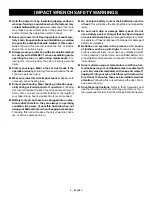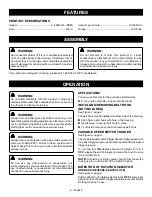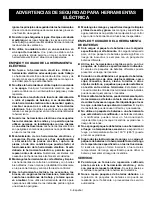
7 - English
OPERATION
Position the direction of rotation selector to the left of the
switch trigger for forward operation. Position the selector to
the right of the switch trigger to reverse the direction.
NOTE:
The tool will not run unless the direction of rotation
selector is pushed fully to the left or right.
NOTICE:
To prevent gear damage, always allow the anvil to come
to a complete stop before changing the direction of
rotation.
WARNING:
Battery tools are always in operating condition. Lock the
switch when not in use or carrying at your side, when in-
stalling or removing the battery pack, and when installing
or removing sockets.
INSTALLING / REMOVING BATTERY PACK
See Figure 3, page 9.
Lock the switch trigger.
Insert the battery pack into the product as shown.
Make sure the latches on each side of the battery pack
snap into place and that battery pack is secured in the
product before beginning operation.
Depress the latches to remove the battery pack.
For complete charging instructions, see the operator’s manu-
als for your battery pack and charger.
LED LIGHT
See Figure 4, page 9.
The LED light at the base of the tool illuminates when the
switch trigger is depressed.
If the tool is not in use, the time-out feature will cause the
lights to start fading and then shut off.
The LED light illuminates only when there is a charged bat-
tery pack in the tool.
MODE SELECTOR
See Figure 4, page 9.
Press the mode selector to cycle between Low (1) speed,
Medium (2) speed, High (3) speed, and Auto Mode (A).
Auto Mode offers protection from over-tightening fasteners.
It allows for greater control, reducing damage to fasteners
and work surfaces. If the tool is in Auto Mode and running
in the forward direction, it will automatically shut down once
it starts impacting. If the tool is in Auto Mode and running
in the reverse direction, it will automatically shut down after
impacting has completed.
The range of speeds available in each setting are:
Auto Mode (A) ............................................0-2,900 RPM
Low (1) .......................................................... 0-850 RPM
Medium (2) ................................................... 0-2,000 RPM
High (3)....................................................... 0-2,900 RPM
NOTICE:
Never change modes while the tool is running. Doing so
may result in serious damage to the tool.
INSTALLING AND REMOVING SOCKETS
See Figure 5, page 9.
Use only sockets designed for impact wrenches. Always
select the correct size impact socket for nuts and bolts.
CAUTION:
Using the wrong size socket may damage the nut or
bolt and cause the fastening torque to be inaccurate or
inconsistent.
Remove the battery pack.
Push the socket onto the anvil until the friction ring locks
it into place.
To remove the socket, pull it away from the anvil.
OPERATING THE IMPACT WRENCH
See Figures 6 - 7, page 9.
CAUTION
:
The metal surface may become hot during use. Avoid
contact with it to avoid possible burn injury.
Proper fastening torque may be determined by the kind of
bolt, the size of the bolt or the material or the workpiece. It
is helpful to perform a test operation to determine the proper
fastening time for the nut or bolt you are using.
Hold the tool with one hand and pointed straight at the
nut or bolt.
Depress the switch and fasten for the proper fastening
time.
Remove the impact wrench from the nut or bolt.
Check the torque with a torque wrench.
NOTICE:
Do not use this tool to install lug nuts on wheels without
a torque limiting device. Doing so could result in galled
or broken lugs.








































